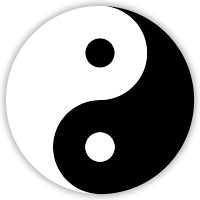Note: This originally was part of the notes for an open class in non-duality, given in the summer of 2005.
The metaphysician claims that every aspect of the empirical world is a symbol of some deeper metaphysical reality. Metaphysically, birth is not a matter of chance; therefore it is not a coincidence for a “being” to find itself in the body of a man or woman. Hence, one’s physical gender, rather than being irrelevant, is a reflection of a spiritual difference; this difference will be manifested in a distinctive dharma.

The most famous traditional symbolism may be the yin/yang symbol of the Tao. The yang (masculine principle) is associated with the virtues of heaven and the yin (feminine principle) with the principle of the earth. In the Samkhya school of Vedic philosophy, the purusha — or impassable spirit —is masculine and prakriti — the matrix of every conditional form — is feminine. Other traditions see in the masculine the principle of unity, and the principle of differentiation in the feminine.
Things are not actually so simple, since, phenomenally speaking, each individual is actually a compound — in varying proportions — of the Male and Female principles. This is developed in the quirky, yet brilliant book, Sex and Character, written by Otto Weininger written at the tender age of 21.
According to Plato’s theory of Soul Mates, an originally unified spiritual being, in manifesting, splits into a male and female, who then perpetually strive to find each other to reunite into their primordial state. Suppose Gomez is 80% male and 20% female, while Morticia is 20% male and 80% female (of course, we do not intend to imply that this can be determined with any such mathematical precision). They would be highly attracted to each other since their union would be a perfect 100% male and 100% female.
There is more implied here: Gomez is attracted to Morticia not only for her femininity, but also for the missing components of his masculinity (and vice versa for Morticia). The greater the differentiation between the man and the women, the greater, and more intense, will be the sexual attraction. However, this attraction comes with the heavy cost of lack of understanding, because to the extent the man lacks the feminine component, he will be unable to understand her mind. Naturally, the opposite consideration will apply to the woman.
In their Otherness, there will be little empathy — Gomez’s understanding of Morticia will be limited by his own psychic makeup, and this misunderstanding cannot be overcome simply by rational discourse or “talking about our relationship”. Therefore, paradoxically, to understand the Other turns out to be a process of Self-realization. As Gomez transcends the merely personal consciousness as “male” to a higher unity, his understanding of Morticia will deepen. And in her own Self-realization, Morticia will discover more of Gomez in her own consciousness. This is how “soul mates” lead each other into the Unity of their Being.
We are now in a position to understand more perfectly what Friedrich Schlegel was getting at, in finding the qualities of wife, mistress, and âme-soeur in the one woman Dorothy. In a “wife” a man is looking for someone similar to him, who understands him. They can plan together, discuss their “day”, talk about the kids, etc. In a mistress, or lover, he is looking for his opposite, where there will be a sexual charge, and no consideration about the mundane. Few get past this point, as they repeatedly substitute a physical unity for the spiritual unity that they are really seeking.
Many today claim to be looking for a “soul-mate”, when what they are really seeking is a mate and lover, which, as we have seen, as two contradictory goals. The French translation is actually more accurate, because the âme-soeur is actually a “Platonic” relationship, transcending the merely physical. In some traditions, this is taken quite literally; for example, the Kabbalistic teachings claim that soul-mates should look somewhat alike, even to the point of being mistaken for brother and sister. On the other hand, we see that the search for one’s “soul-mate” is futile without a corresponding process of Self-realization to be able to recognize him or her.
Apparently, Schlegel was able to recognize his soul-mate in Dorothy. On the surface, she seemed an unlikely choice. She was divorced at a time divorce was rare and disreputable, already with two children from the previous marriage, and eight years his senior. Yet he accepted her as his life partner and bonded with her children. The passion with which he writes about her attests to their strong and vibrant physical attraction. And, as his âme-soeur, he found someone to share their viewpoints on life, art, philosophy, and spirituality in that eternal conversation that constitutes a proper marriage.
And, most importantly, for Schlegel, this is not philosophy or psychological theory to be studied, but, rather, it for him it is Life itself.
Please be relevant.